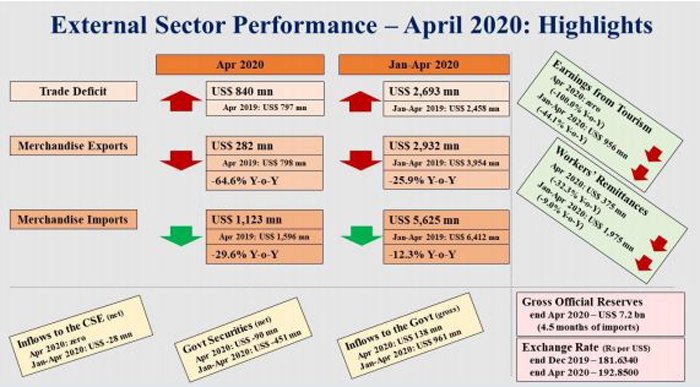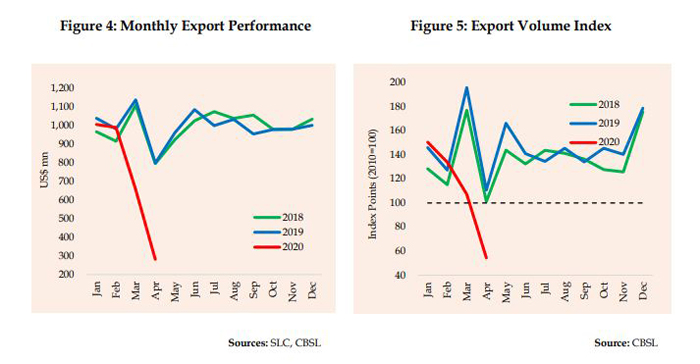June, 23, 2020

According to the latest external trade data released by the Central Bank, country’s trade deficit widened in April 2020 as exports fell more than the decline in imports.
Sri Lanka’s external sector performance in April 2020 was severely affected by the COVID-19 pandemic related economic interruptions.
The imposition of a partial lockdown had a significant impact on Sri Lanka’s merchandise exports sector while shutting down the tourism industry in April 2020.
The expenditure on merchandise imports also declined, with disruption to import related supply chains and restrictions imposed on non essential imports by the government and the Central Bank.
The deficit in the trade account widened in April 2020 to US dollars 840 million, from US dollars 797 million in April 2019, as the decline in exports exceeded the decline in imports.
However, on a cumulative basis, the trade deficit widened to US dollars 2,693 million during the first four months of 2020 from US dollars 2,458 million in the corresponding period of 2019.
Meanwhile, terms of trade, i.e., the ratio of the price of exports to the price of imports, deteriorated by 16.4 per cent (year on year) in April 2020 as export prices declined at a faster pace than the decline in import prices.
Exports
In comparison to April 2019, earnings from merchandise exports declined significantly by 64.6 per cent to US dollars 282 million in April 2020, continuing the year-on-year decline observed in March 2020, with all major export sectors recording significant declines.
Disruptions to domestic production processes, disruptions to export related services due to the imposition of curfew and disturbances to both domestic and global supply and demand chains due to the outbreak of the COVID-19 pandemic were the main reasons for this sharp decline in the earnings from exports.
Earnings from the three major exports sectors; agricultural, industrial and mineral exports, recorded significant contractions in April 2020. Major export products such as textiles and garments, rubber products, petroleum products, gems, diamonds and jewellery, tea, seafood and machinery and mechanical appliances mainly contributed to the decline in export earnings.
Both the export volume index and the unit value index declined by 50.6 per cent and 28.4 per cent, respectively, in April 2020, indicating that the decline in exports was driven by lower volumes and lower prices, compared to April 2019.

Imports
Expenditure on merchandise imports declined notably, on a year on year basis, by 29.6 per cent to US dollars 1,123 million in April 2020 mainly led by the significant declines in intermediate and investment goods. Measures taken by the government and the Central Bank during March and April 2020 due to the COVID-19 pandemic, including the suspension of facilitating the importation of selected goods contributed to the decline in import expenditure. Despite an increase in the import of food and beverages, the expenditure on consumer goods declined, although at a slower pace, led by lower imports of non-food consumer goods.
The selective import clearing process followed by the Sri Lanka Customs (SLC), prioritising essential consumer items and the disruption to other import related services due to the imposition of curfew, disruptions to global supply and logistic chains, lower commodity prices following the COVID-19 outbreak were the main reasons for this significant decline in the expenditure on imports.
Accordingly, expenditure on all major import sectors; consumer, intermediate and investment goods, declined in April 2020. Lower average import prices of crude oil (in April, average import price was US dollars 19.56 per barrel), refined petroleum and coal as well as the lower import volumes of refined petroleum and crude oil mainly accounted for the decline in expenditure on fuel. Expenditure on machinery and equipment, textiles and textile articles, building material, wheat and maize, mineral products and transport equipment imports recorded notable declines.
Expenditure on non food consumer goods such as telecommunication devices, clothing and accessories and home appliances, which were mainly subjected to import restrictions imposed during March/April 2020 also decreased in April 2020. However, a considerable
increase on import expenditure on personal vehicles was observed in April 2020 compared to the previous month, mainly due to the clearing of the backlog accumulated due to service disruptions with the spread of COVID-19 in the country.
In addition,expenditure on food and beverages, categorised under consumer goods imports increased, led by essential goods such as vegetables, seafood and spices while expenditure on base metals, fertiliser, agricultural inputs and food preparations imports categorised under intermediate goods also increased.
Both the import volume index and the unit value index declined by 17.8 per cent and 14.4 per cent, respectively, in April 2020, indicating that the decrease in imports was driven both by lower volumes and lower prices when compared to April 2019.

Video Story